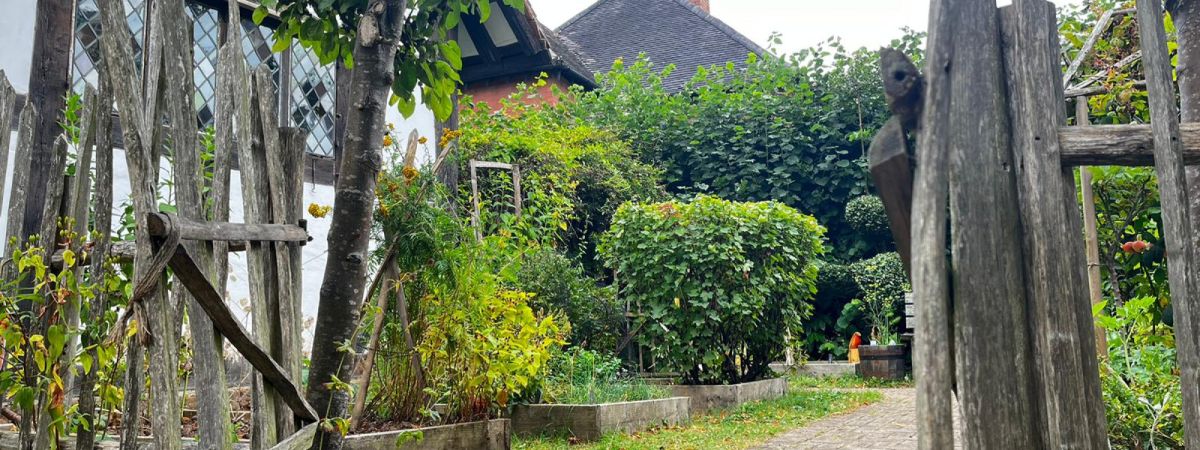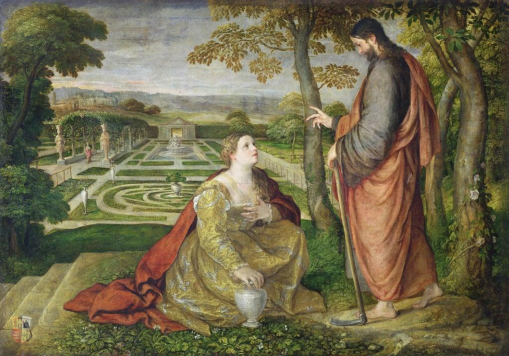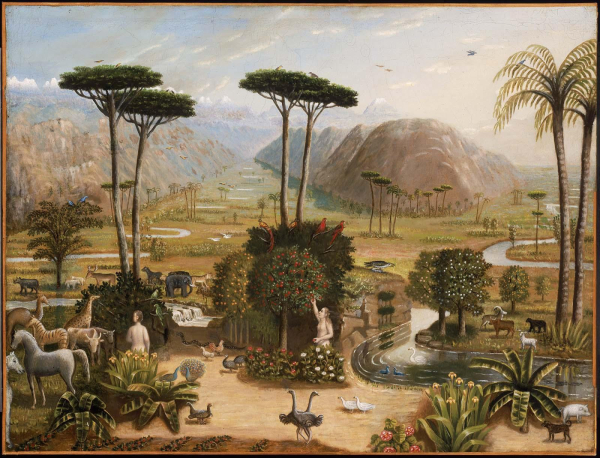The Medicinal and Spiritual Importance of Gardens in the Tudor and Stuart Period

Share
The great value of garden space within the early modern period of English history is not a frequently discussed topic, and much of the information we learn about Tudor and Stuart life today is largely related to aristocratic or royal life. However, this blog aims to briefly explore how the average household may have utilised the green land around their home for various means, so that we can possibly see how the gardens we now have at Selly Manor may echo back to their original intended use. Some of the reasons why gardens were considered important within these periods are still relevant in our contemporary world, while others offer more interesting and archaic explanations.
It is initially important to note that there were various established forms of gardens, each with its own purpose in a plot of land, or more rarely a public space. Within the book Paradisi in sole paradisus terrestris (1629), famed botanist John Parkinson (1567 - 1650), who was also the Royal Botanist to King Charles I, described there being three main types - flower gardens or gardens of pleasure, vegetable/herb gardens, and orchards.[1] Arguably, the most essential role of a garden was for restorative or medicinal procurements - this purpose extended mainly across the pleasure garden and the herb garden.

Above: Noli Me Tangere by Lambert Sustris
oil on canvas, circa 1548-1560
Museum of Fine Arts, Boston
Herb Gardens
Herb gardens had a rather practical usage and were frequently used by the average household. This is because most medicinal cures were created at home, and the ingredients used would be grown or otherwise produced often by the women of the family. For example, there is a memoirist by the name of Elizabeth Freke (1641 - 1714), who kept an expansive record of her own recipes, as well as a record of the medicine she had in her personal stock. From primary sources like this, we can see what kinds of plants were used in home remedies and in turn what someone of the Stuart era may have grown in their garden.[2] These recipes may have been self-invented through trial and error, spread through friends and family, as well as sourced from publications such as almanacs and herbology books.
To understand the importance of herb gardens regarding domestic cures across eras, we must contextualise the medical environment in which people would have been living in. It has been noted that by 1598 there were only 38 members of the Royal College of Physicians, and that between 1530 - 1603, there were only 2 physicians in the entire county of Bedfordshire. These were official and orthodox practitioners, and it is clear that their presence was minimal. Therefore, it can be seen that the vast majority of healthcare would fall to families themselves, or to people like wise men and women (cunning folk). Furthermore, many medical publications were inaccessible to the general public (although London publishers had released around 100 works in English as opposed to Latin or Greek through the 16th century), thus emphasising the importance of peer-to-peer recipe exchange, and the need to source ones own medicine.[3] It was also naturally believed important to be able to actually identify herbs, and there were several botanical works that addressed this issue, some being William Langhams The Garden of Health (1597) and William Turners A New Herball (1551 - 68). The study of plants remained firmly intertwined with medicine for the entirety of the period, and consequently emphasised how natures uses were perceived as tools in achieving good health.[4]
Pleasure Gardens
The pleasure garden is a rather recognisable concept in todays society, and even through the 17th century, had very similar reasons behind its purposes to those of rising garden suburbs and much later Victorian garden cities. Although there is of course a difference in the scientific understanding between the Tudor or Stuart and the Victorian behind why green, pleasant spaces, were beneficial to ones health, the main overarching sentiment is one of a holistic or spiritual quality. Western medieval medicinal theory still commanded a huge influence within the Tudor period, both in terms of Hippocratic and Galenic practice, and is reflected in the presence of theories such as miasma, which is most commonly associated with the spread of the Black Death.
The believed presence of miasma, or noxious air, played one of the most vital roles in the early modern approach to health and wellbeing. It became understood by many that the quality of the air in the area you lived in could greatly determine your quality of life and susceptibility to malady. Intellectual and gardener John Evelyn (1620 - 1706) maintained ardently that country people lived longer and healthier lives than those who dwelt in filthy and polluted cities and such places were inviron'd with rotten dung, loathsome and common lay-stalls; whose noisome streams, wafted by the wind, poison and infect the ambient air and vital spirits with those pernicious exhalations.[5] In 1661, he published a pamphlet in initial address to King Charles II by the name of Fumifugium, or the Inconveniencie of the Aer and Smoak of London Dissipated, in which he argued that industry was polluting Londons air, and should be rectified by the reduction of industrial practice, and more notably the improvement and melioration of the aer of London by way of plantations [6] - in common parlance, improvement through the act of planting more trees and flowers. Despite the fact that Evelyn and his contemporaries understanding of poor air quality was scientifically inaccurate, and over a century before the discovery of oxygen, we can clearly see how similar ideas around the requirement of plants for clean, fresh air are held today.

Above: John Evelyn by Robert Walker
oil on canvas, 1648-circa 1656
National Portrait Gallery, London
On the other hand, there was also in retrospect a rather eccentric medieval theory relating to the visual benefit of these gardens. Under Aristotelian belief, the eye was considered to some as a passive organ which absorbed images from the outside world, and these images were physical manifestations which travelled into the body and could have a profound effect on its health, especially those of pregnant women and their babies in utero. It was therefore concluded that seeing a beautiful landscape would have an immediate positive impact on ones being (and in contrast, seeing something disturbing like a corpse would have a negative one). These attitudes, like many others from the Middle Ages, may have continued and survived in the motivations behind the increasing the importance of aestheticism in pleasure gardens.[7] We can see this reflected in how the trends of garden positions themselves in relation to the rest of the household altered into the Jacobean era, namely that it was desired for both units to work together symmetrically. Whereas before, through the Tudor and even medieval periods, it was more widespread for a garden to always lie next to a certain section of the house, commonly the gallery and parlour.[8] It can be easy to forget that there may have always been an interest in landscaping, and furthermore that there were sets of connotations or reasons that would have accompanied certain physical configurations.
Recreating Eden
When following the movement of thought relating to the importance of how a garden is structured, it is possible to reach other motivations that cater increasingly to the spiritual aspect of healing. There is an interesting phenomenon that has been researched to a minor extent, addressing the religious significance of the garden.
The concept of the Garden of Eden in the public consciousness was thoroughly enriched by the development of pleasure gardens, with inspiration sourced from ancient Greek and Hellenistic to humanist Renaissance influence. Literature and art perpetuated this concept of Eden as paradise, connecting it to love, peace, and grace. These are all ideas which are desirable to mankind, and thus many horticultural books capitalised on this aspiration to achieve prelapsarian bliss by encouraging a sense of order in ones own garden. As Eden was divinely ordered, so shall your own be. John Parkinson, a botanist mentioned previously, for example recommended a quincunx arrangement for an orchard - i.e. four points in a square shape with one in the centre, like the fifth side of a die. This is just a small instance of how order was perceived as aspirational.

Above: The Garden of Eden by Erastus Salisbury Field
oil on canvas, circa 1860
Museum of Fine Arts, Boston
Not only does this pursuit aim to achieve peace and grace, but it emphasises the importance of hard work and toiling the land. The believed impoverished fertility of the soil after the fall of man could possibly be rectified with hard work once again, in the footsteps of Adam.[9] This concept was utilised quite heavily through the medieval periods, with religious houses, monasteries, and hospitals often having garden spaces for reflection on sin and retribution, as well as offering physical labour. It has been said that the very act of weeding and digging served as a sharp reminder that such backbreaking work was concomitant of original sin.[10]
Although these are largely Catholic meditations, and Englands movements of Christianity shifted frequently through the early modern centuries - most notably with Henry VIIIs reformation - people consistently maintained that there was great significance in this connection to the Book of Genesis. To look after a garden with these ideas in mind could be considered an accessible method in finding connection with God and spirituality, which were of course highly important, and in reflection of general and popular belief, almost necessary.
Written by Tris, Volunteer
Edited by Megan, Museum Assistant (who learnt so many new niche words and now knows how to use ardently in a sentence.)
Footnotes
[1] BARTOS, J. (2010). THE SPIRITUALL ORCHARD: GOD, GARDEN AND LANDSCAPE IN SEVENTEENTH-CENTURY ENGLAND BEFORE THE RESTORATION. Garden History, 38(2), 177193.
[2] LEONG, E. (2008). Making Medicines in the Early Modern Household. Bulletin of the History of Medicine, 82(1), 145168.
[3] SANGWINE, E. (1978). The Private Libraries of Tudor Doctors. Journal of the History of Medicine and Allied Sciences, 33(2), 167184.
[4] OMALLEY, C. D. (1968). Tudor Medicine and Biology. Huntington Library Quarterly, 32(1), 127.
[5] RAWCLIFFE, C. (2008). Delectable Sightes and Fragrant Smelles: Gardens and Health in Late Medieval and Early Modern England. Garden History, 36(1), 321.
[6] EVELYN, J. (1661). Fumifugium, or, The inconveniencie of the aer and smoak of London dissipated together with some remedies humbly proposed by J.E. esq. to His Sacred Majestie, and to the Parliament now assembled.
[7] RAWCLIFFE, C. (n 5)
[8] SCHOFIELD, J. (1999). City of London Gardens, 1500-c. 1620. Garden History, 27(1), 7388.
[9] BARTOS, J. (n 1)
[10] RAWCLIFFE, C. (n 5)